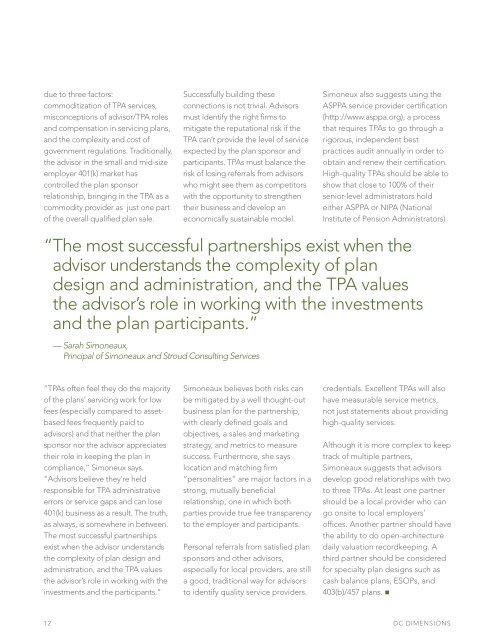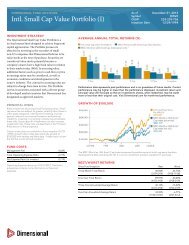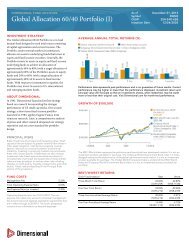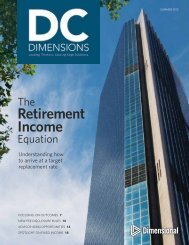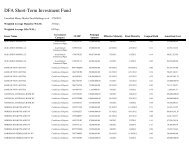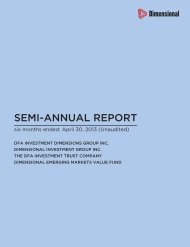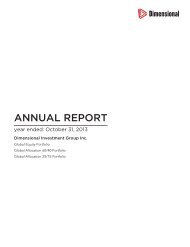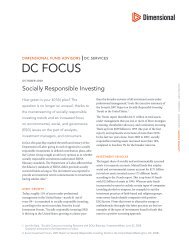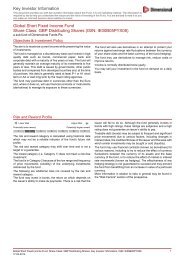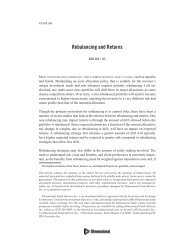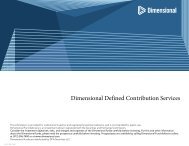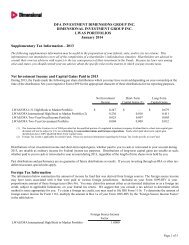Global Retirement Plan Innovation - Dimensional Fund Advisors
Global Retirement Plan Innovation - Dimensional Fund Advisors
Global Retirement Plan Innovation - Dimensional Fund Advisors
You also want an ePaper? Increase the reach of your titles
YUMPU automatically turns print PDFs into web optimized ePapers that Google loves.
due to three factors:<br />
commoditization of tPA services,<br />
misconceptions of advisor/tPA roles<br />
and compensation in servicing plans,<br />
and the complexity and cost of<br />
government regulations. traditionally,<br />
the advisor in the small and mid-size<br />
employer 401(k) market has<br />
controlled the plan sponsor<br />
relationship, bringing in the tPA as a<br />
commodity provider as just one part<br />
of the overall qualified plan sale.<br />
“tPAs often feel they do the majority<br />
of the plans’ servicing work for low<br />
fees (especially compared to assetbased<br />
fees frequently paid to<br />
advisors) and that neither the plan<br />
sponsor nor the advisor appreciates<br />
their role in keeping the plan in<br />
compliance,” Simoneux says.<br />
“<strong>Advisors</strong> believe they’re held<br />
responsible for tPA administrative<br />
errors or service gaps and can lose<br />
401(k) business as a result. the truth,<br />
as always, is somewhere in between.<br />
the most successful partnerships<br />
exist when the advisor understands<br />
the complexity of plan design and<br />
administration, and the tPA values<br />
the advisor’s role in working with the<br />
investments and the participants.”<br />
Successfully building these<br />
connections is not trivial. <strong>Advisors</strong><br />
must identify the right firms to<br />
mitigate the reputational risk if the<br />
tPA can’t provide the level of service<br />
expected by the plan sponsor and<br />
participants. tPAs must balance the<br />
risk of losing referrals from advisors<br />
who might see them as competitors<br />
with the opportunity to strengthen<br />
their business and develop an<br />
economically sustainable model.<br />
Simoneaux believes both risks can<br />
be mitigated by a well thought-out<br />
business plan for the partnership,<br />
with clearly defined goals and<br />
objectives, a sales and marketing<br />
strategy, and metrics to measure<br />
success. Furthermore, she says<br />
location and matching firm<br />
“personalities” are major factors in a<br />
strong, mutually beneficial<br />
relationship, one in which both<br />
parties provide true fee transparency<br />
to the employer and participants.<br />
Personal referrals from satisfied plan<br />
sponsors and other advisors,<br />
especially for local providers, are still<br />
a good, traditional way for advisors<br />
to identify quality service providers.<br />
Simoneux also suggests using the<br />
ASPPA service provider certification<br />
(http://www.asppa.org), a process<br />
that requires tPAs to go through a<br />
rigorous, independent best<br />
practices audit annually in order to<br />
obtain and renew their certification.<br />
High-quality tPAs should be able to<br />
show that close to 100% of their<br />
senior-level administrators hold<br />
either ASPPA or nIPA (national<br />
Institute of Pension Administrators)<br />
“ the most successful partnerships exist when the<br />
advisor understands the complexity of plan<br />
design and administration, and the tPA values<br />
the advisor’s role in working with the investments<br />
and the plan participants.”<br />
— Sarah Simoneaux,<br />
Principal of Simoneaux and Stroud Consulting Services<br />
credentials. excellent tPAs will also<br />
have measurable service metrics,<br />
not just statements about providing<br />
high-quality services.<br />
Although it is more complex to keep<br />
track of multiple partners,<br />
Simoneaux suggests that advisors<br />
develop good relationships with two<br />
to three tPAs. At least one partner<br />
should be a local provider who can<br />
go onsite to local employers’<br />
offices. Another partner should have<br />
the ability to do open-architecture<br />
daily valuation recordkeeping. A<br />
third partner should be considered<br />
for specialty plan designs such as<br />
cash balance plans, eSOPs, and<br />
403(b)/457 plans. �<br />
12 DC DIMenSIOnS


